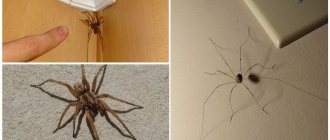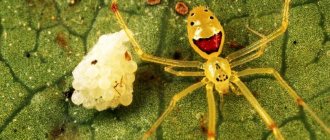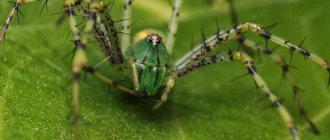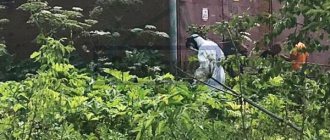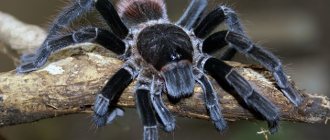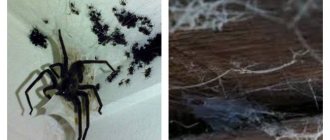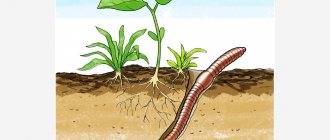The fauna of our planet is full of a huge number of living creatures that fascinate with their diversity, so it is often difficult to immediately determine what species an organism belongs to.
For example, not many people know that spiders belong to animals, a phylum of arthropods and a class of arachnids . There are more than 42 thousand species of spiders, of which 1.1 thousand are fossils.
Moreover, they can be found everywhere, even where no living creature can live. This article will take a detailed look at who spiders are and what they are.
Description of the spider
The spider is the most ancient creature on the planet. It is much older than humans; these organisms arose in advance. The remains of vital activity, spider webs, were discovered in the structure of amber, which is 100 million years old.
Arachnids lived on the globe back in the Paleozoic era, and this was 2.5 billion years ago. During this period, these creatures practically did not change in appearance.
To understand who spiders are, it is worth considering their features and description of their appearance. They have 6 pairs of limbs. However, the person notices 4 pairs. This is due to the fact that the first 4 limbs are transformed into organs of nutrition and touch.
General characteristics include the following appearance criteria:
- The body of arthropods is divided into two parts - the cephalothorax and abdomen. They are connected using a short jumper;
- the cephalothorax is divided by a groove into the head and thoracic parts;
- on the chest part there are the limbs of the spider, due to which it moves and weaves a web;
- on the surface of the head there are two pairs of limbs, eyes and a mouth opening.
The number of eyes may vary. Most arthropods have 8 visual organs. But in individuals living in the darkness of caves, they may be absent.
Why is a spider not an insect?
Spiders, especially small ones, are similar in appearance to insects, but are not insects. But why is a spider not an insect?
Insects and arachnids are divided into two different classes, which belong to the same phylum of animals - arthropods. They have some similarities in structure, but there are many more differences. Family connections are revealed by the chitinous cover and some details of the body structure: the chest and abdomen are connected by a thin stalk, legs are located in pairs on the sides of the chest. Only an insect has six legs, and a spider has eight. In addition, the spider has chelicerae - small limbs with poisonous claws located next to the mouthparts.
The front part of the body is also different: in insects the movable head is separated from the chest; in arachnids there is not even any semblance of a “neck”; the head is combined with the chest into one part of the body, which is called the cephalothorax.
Insects have two eyes with a complex structure, spiders have much more primitive eyes, but there are eight of them. There are spiders with six eyes and rarely with two.
Insects are carnivores and vegetarians. The former eat their food with powerful jaws and literally chew their food; the latter mainly feed on nectar using “proboscis”. The feeding of spiders is radically different - they inject gastric juice into their prey, wait until the soft tissues soften and then suck up the nutritious “soup” through a narrow mouth slit, devoid of teeth, lips and, in general, any signs of the oral apparatus familiar to us. Almost all spiders are predators; only one species has been found that feeds on plants - Kipling's bagheera spider.
The head of all types of insects is decorated with a pair of antennae; spiders do not have these antennae.
Another striking difference is the web. Spiders have three pairs of arachnoid warts that release a thin stream of sticky liquid, which hardens after a few seconds without losing its stickiness. A spider's web is a trap for insects that do not know how to create such deadly laces.
By the way, the spider is much more closely related than insects to scorpions and mites, which also belong to the class of arachnids.
Signs of insects
The insect's body is divided into head, thorax and abdomen. The head consists of five fused segments. There are antennas on the head with receptors for touch and smell. The eyes are compounded, that is, they consist of many simple ocelli. There are mouthparts for chewing food.
The chest includes segments: anterior, middle and posterior. Each segment carries a pair of motor limbs. In addition, the middle and hind ones each include a pair of wings: chitinized elytra and, in fact, wings. The abdomen also consists of segments, on the sides of which paired respiratory openings open.
Signs of arachnids
Signs characteristic only of arachnids show how different spiders are from insects. They answer the question: is a spider an insect or not?
The spider's body is divided into the cephalothorax and abdomen. That is, there is no jumper between the head and chest; they are fused during evolution. And in such an arachnid as the haymaker, even the cephalothorax is fused with the abdomen. Haymakers often settle in human houses. They have long legs, but they should be distinguished from the long-legged spider, whose cephalothorax and abdomen are separate.
The absence of antennae distinguishes spiders from insects. But there are chelicerae - limbs bearing claws. They serve to inject poison into the victim. The chelicerae of males are noticeably longer than those of females. Pedipalps are a sign of spiders. They look like a fifth pair of legs. However, spiders do not rely on it; they use it to capture prey.
Spiders' eyes are not compounded. They have from one to six pairs of eyes. Most often 8. However, vision is very poor. They distinguish objects at distances of up to 30 centimeters.
Spiders do not chew their prey. They have a narrow mouth opening with which they suck in already digested liquid. To do this, they first inject into the victim, in addition to poison, digestive juice. They wait for some time until the food is digested. They will suck up the finished liquid and can add digestive enzymes to it again. This method of digestion is called extraintestinal.
The cephalothorax consists of six fused segments, each bearing a pair of limbs: chelicerae, pedipalps and walking limbs. Spiders have eight legs and no wings.
The arachnoid glands are located in the lower part of the abdomen. Only spiders weave the web needed for hunting. The vast majority of spiders are predators.
The respiratory organs are not only the trachea, but also the leaf-shaped lungs. The latter are depressions in the abdomen. Their walls form many thin plates. Through them, gases diffuse into the hemolymph. The lungs open outwards with breathing holes.
Sources:
https://footyclub.ru/hobbi/schitaetsya-li-pauk-nasekomym-pauk-eto-kto-nasekomoe-ili-zhivotnoe/
https://zooclub.ru/faq/show.php?id=3768
https://irgp2.ru/otnositsya-li-pauk-k-nasekomym-i-pochemu-pauk-otnositsya-k-zhivotnym-ili/
Is a spider an insect or not?
Many people wonder whether a spider actually is an insect or an animal. Most will immediately answer that it is an insect, but this is not the case. Even if in appearance this organism looks like crawling small inhabitants, it is in no way related to them and has distinctive features.
They are animals; among the inhabitants of the fauna they are classified as invertebrates. These are arthropods that have jointed limbs, a hard chitinous cover, which is a hard exoskeleton.
Therefore, the question arises why spiders are not insects and animals. And also interested in what exactly connects mammals, what common features they have with insects and differences from them. This is worth considering carefully.
General signs
The family of spiders and insects share some common characteristics. This is due to the fact that arachnids belong to the class of arthropods.
They have the following characteristic qualities:
- creatures have a chitinous skeleton to which muscles are attached;
- the structure of the eye in arthropods is formed from many ocelli; it is often called facet;
- females reproduce by laying eggs.
Main differences
To understand what a spider is - an animal or an insect, it is worth carefully considering its main characteristics.
Many people mistakenly consider it an insect, but this is not so, and this is indicated by the following distinctive features:
- spiders have 8 legs, and insects have 2 fewer;
- Insects have 3 body segments, and arachnids have 2;
- spiders are able to weave webs;
- In nature, insects have a huge number of species and subspecies;
- arthropods produce poison, which is required for external digestion of food;
- unlike insects, arachnids do not have metamorphism (transformation) in their life cycle;
- The communication system and nervous system of insects is much more complex than that of arthropods.
How is a spider different from insects?
Although spiders, like insects, belong to the class of arthropods, they are not insects. Spiders belong to the class Arachnida, insects belong to the class Insects.
See the main differences between these two types below:
Spider
- 8 legs;
- the body consists of two parts, the head connected to the chest (cephalothorax) and the abdomen;
- jaws have cutting properties;
- spiders cannot fly;
- Spiders don't have antennae.
Insects
- 6 legs;
- the body consists of three parts: head, chest and abdomen;
- jaws are suitable only for chewing or crushing food;
- many insects have wings, and many of them can fly;
- insects have two antennas on their heads.
Zophobas beetle
The usual size of a spider ranges from a few millimeters to 10 centimeters. But there are certain species, for example Goliath tarantula spiders, which can reach a size of up to 30 centimeters.
In spiders, the body is divided into two clearly distinguishable regions: the cephalothorax, known as the prosoma (anterior part), and the abdomen, known as the opisthosoma (posterior part). All other parts of the animal are connected to the cephalothorax; these are eight legs, two chelicerae and two pedipalps.
Brachypelma Smitty top view
Chelicerae belong to the oral part, and are used for feeding and obtaining food. In most spiders, these chelicerae are associated with glands that secrete venom, which is used to paralyze or kill prey.
The pedipalps are similar to legs, but never touch the ground because they are shorter than the legs. They serve for reproduction as a copulatory device for introducing sperm into the female's body.
In the back of the spider there are glands that produce silk, which is used to make webs. All types of spiders have this property and they need it to capture prey and immobilize it and store it, they build a shelter from it and wrap their future offspring in it.
We recommend: Brachypelma spider, description, maintenance and care
The digestive system consists of the pharynx and stomach in the cephalothorax, and the intestines in the abdomen. At the top of the opisthosoma is the heart. Spiders respire through lungs known as phylotrachea.
The spider's digestion is external; having caught prey, it injects poison into it, which paralyzes or kills it, and then injects digestive juice into it. This juice turns the victim into a mushy state, which the spider then happily consumes.
Spiders use pedipalps for smell and touch.
Unlike insects, most spiders have poor vision, even though they have 2 to 8 eyes, this does not help them much, but there are some species with good vision, such as jumping spiders.
Interesting facts about spiders
Unusual facts about spiders will amaze many who do not yet know about these creatures. But they conceal many mysteries, secrets, and have unique features that other organisms living on the globe do not have.
Let's look at 15 interesting facts about spiders:
- The web is not only a trap for insects, it is capable of deflecting several millimeters in order to grab and stick an insect to itself. This phenomenon is carried out due to a static charge, which appears during the flight of the insect.
- The bite of the Brazilian wandering spider is not always fatal, but it often causes impotence in men.
- With the help of its limbs, the spider can determine what has reached it in the web. But edible or inedible helps him establish the olfactory organs, which are located on his legs.
- The animal has a durable shell. Its strength can withstand a nuclear explosion.
- The web is very light. If you take a spider thread the length of the earth's equator, then its weight will be only 340 grams.
- Spider web is considered a powerful and durable material. If its thickness is increased to the thickness of a pencil, then such a web could stop a Boeing. In New Guinea, fishermen use this material to catch fish, and in South America there are spider web bridges that support monkeys.
- The lifespan of arthropods is 30 years. But they rarely die of old age.
- At one time, the female can lay up to 20 thousand eggs, from which spiders hatch.
- In nature, there are varieties of spiders that, after being born, eat their mother.
- There are varieties of arachnids in which the brain occupies the largest part of the body, so other organs are forced to be located on the legs. The smaller the spider, the larger its brain.
- In the Netherlands there are more spiders than people. For 15 million human population there are 5 thousand billion arthropods.
- In Cambodia, people enjoy eating tarantula spiders. They are also brought up at home, they learn to dance, and play willingly. And if necessary, they can protect the owner.
- There are types of spiders that do not weave webs - the jumping spider, the lynx spider. They do not catch prey with webs, but hunt it.
- Tarantulas can live without food for about two years.
- The gladiator got its name due to the fact that it weaves a web in a square. He does not leave her until the prey falls into her; he himself abruptly throws the net on her, thereby leaving no chance to escape.
Species and subspecies
Answering the question of what kinds of spiders there are, it is worth noting that these creatures are divided into species and subspecies, which have some distinctive features.
In nature, there are about 35 thousand species of archanids or arachnids, which differ in appearance.
Different types of spiders have characteristic forms of life activity, which include reproduction, feeding habits, habitat in natural conditions, and size.
Characteristic features include:
- their body consists of two parts - the abdomen, which can have different shapes, it all depends on the type of arthropod, as well as the cephalothorax;
- characterized by the presence of 4 pairs of legs, 2 chelicerae and pelipalps;
- spiders do not have whiskers;
- the main feature of the creatures is to weave webs for various purposes, and its design may have some peculiarities;
- there are poisonous glands, the poison of which has a paralyzing effect on the victim;
- prefer to lead a solitary lifestyle. Most females, after fertilization, eat a select few.
It is impossible to know exactly how many spiders there are in the world, because there are many of them.
At one time, a female is capable of laying 15-20 thousand eggs, most of which hatch into spiders, so it is difficult to imagine how many dozens of females can lay and give birth at a time.
The classification combines many types. In nature, there are exotic representatives of arthropods that do not pose a danger to humans; they are preferred as pets.
It is worth paying attention to the dangerous and poisonous breeds of spiders; they inhabit the tropics and other hot areas, for example, deserts.
Features of arachnids
Obviously, not all arachnids are the same. Biologists have found differences among representatives of this type of arthropod. Several main signs that spiders are not insects and also differ from other arachnids:
- the cephalothorax has no antenna, there are only 4 pairs of simple eyes, a pair of jaws and 2 pedipalps;
- basically have no wings;
- 4 pairs of articulated legs are attached to the cephalothorax;
- the abdomen is not segmented and is connected to the cephalothorax by a thin “waist”;
- the body is covered with an exoskeleton, and sensory hairs grow from the skin.
Interestingly, spiders have claws located at the end of each limb . The spider leg consists of seven segments: cox, trochanter, femur, patella, tibia and finally the tarsus, which may end in two or three small claws. Such features are necessary in order to help the animal cling to its web.
All 4 pairs of legs have muscles that attach to the inner wall of the cephalothorax and intestines. Surprisingly, it is precisely this internal structure that helps the spider suck out food. The circulatory system of these arthropods consists of a heart, arteries and veins, but does not have capillaries. The heart muscle has one cavity and, with the help of valves, moves blood in one direction. By the way, the color of spider blood is blue; it received such an unusual coloring due to hemocyanin dissolved in the lymph.
Spiders (like insects and animals) have a respiratory system, represented in these creatures by the trachea and lungs. The structure of lung tissue, of course, is very different from the human respiratory organs. All arachnid families do not have a muscular respiratory mechanism.
What order and class do spiders belong to?
If we talk about what class spiders belong to, then this is the class “arachnids”. It stands apart from all others, which is associated with the characteristic features of the body structure of arthropods.
They have it divided into two parts - the abdomen and the cephalothorax, but in representatives of other classes the body has a slightly different structure.
There is another characteristic difference - the number of legs. Arthropods have 8 of them instead of 6. They have chelicerae, which are located on the front of the cephalothorax.
They also have pedipalps, which look like tentacles. They are located on the sides of the body and perform the same functions as the paws.
These organisms belong to the order Spiders, the family Arthropods. Spiders are often called "archans", this name comes from the name of the suborder to which these creatures belong - Orthognatha.
It is distinguished by species diversity and specific appearance.
This suborder includes spiders called mygalomorphs. The body of representatives of this species is completely covered with short hairs. They prefer to live in dungeons.
The group includes the following species:
- tarantulas;
- ctenises;
- funnel spiders;
- diggers.
Features of reproduction
During the process of active growth, spiders from time to time shed their tight shell, which consists of a chitinous structure. They gradually acquire a new, stronger one.
Over the entire period of their life, they can molt up to 10 times . Spiders are heterosexual individuals, with the female being much larger than the male.
The mating period lasts quite a long time, its season begins in mid-autumn and lasts until early spring. At this time, the male fills the bulbs, which are located at the ends of the pedipalps, with sperm, then he goes in search of the female.
After performing the “mating dance” and fertilization, the male leaves and dies in the subsequent period.
As soon as 2.5 months have passed, the female lays eggs. After 35 days, spiderlings hatch from them and live in the web until the first molt. Sexual maturity in females occurs at the age of 3-5 years.
What do spiders eat and how do they reproduce?
Spiders are predatory animals and good hunters. When hunting, they can use a variety of methods, from passively sitting near traps built from webs, to actively searching and tracking their prey.
Male spiders have a complex courtship ritual, but it consists mainly of trying to avoid being captured by a female spider, which is much larger in size, and using the pedipalps to introduce their sperm into the female’s reproductive tract. And the most important thing is to try to survive in this process by avoiding the bite of the female; unfortunately, few people succeed in this.
Little baby spider Brachypelma Smitty
As a result of fertilization, the female lays up to 3000 eggs. In some species of spiders, the females die immediately after laying eggs, while some species fiercely defend them until hatching. Spiders go through the entire larval stage in eggs, and are born as small spiders.
We recommend: 7 interesting facts about crocodiles
Feeding spiders
The spider is considered a predatory creature by nature. Its diet mainly consists of insects, and it can sometimes catch small animals. The exception is the jumping spider; it prefers to eat only plant foods (grass, berries, leaves).
The arthropod hunts using nets that it skillfully weaves from cobwebs. In nature, there are varieties of these creatures that use web shots during hunting, while they hypnotize the prey, leaving it no chance to escape.
Despite the fact that they are considered obligate predators, catching prey on their own, they do not have teeth . To eat prey, they need to dissolve its tissues and make a nutritious broth from it.
For these purposes, spider venom is used; the animal injects it into the victim through hollow chelicerae. This allows you to achieve two goals - killing the prey and obtaining a nutrient solution.
